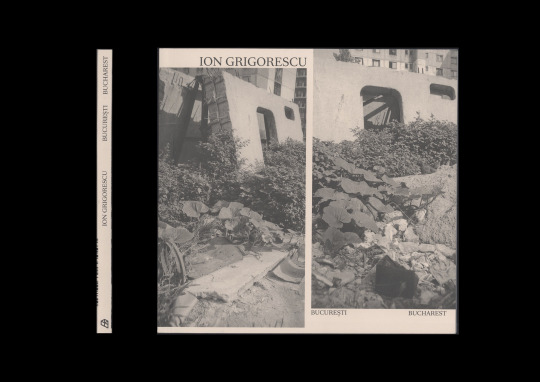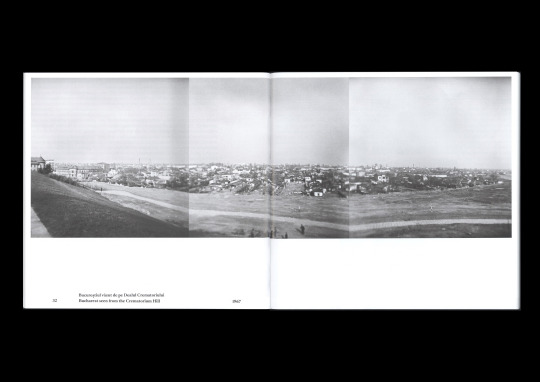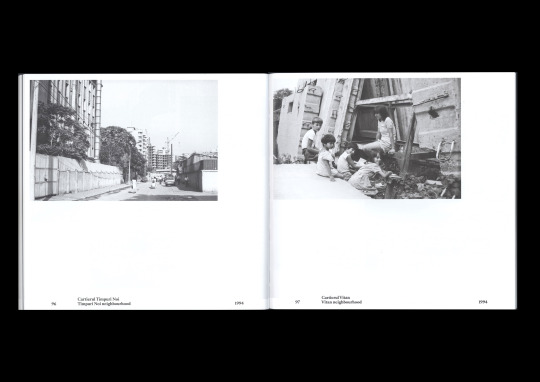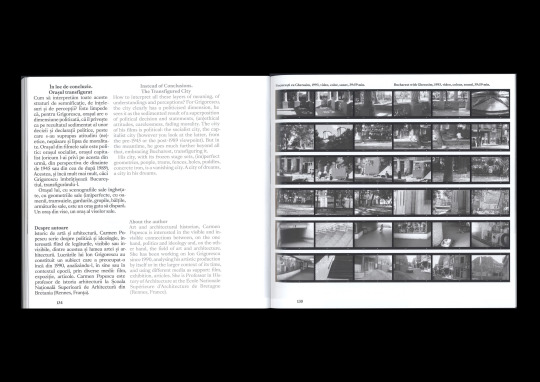#ion grigorescu
Video
undefined
tumblr
Geta Brătescu, May 4, 1926 / 2023
(Geta Brătescu, Atelierul (The Studio), (8mm-film transferred onto DVD, 4:3, silent, black and white, 17'45"), Camera by Ion Grigorescu, 1978. Hauser & Wirth, Zürich. Ivan Gallery, București. © The Estate of Geta Brătescu)
#art#film#video#performance#drawing#visual writing#geta brătescu#birthday anniversary#ion grigorescu#hauser & wirth#ivan gallery#1920s#1970s#2020s
95 notes
·
View notes
Text










I am delighted to have been able to coordinate this project with Laura Bivolaru and Claudia Retegan at the 2/3 galeria in Bucharest.
Expanded Spatialities
Show curated by Laura Bivolaru
Open until 6th of October 2024
Artists: David Barreiro, Bogdan Bordeianu, John Divola, Vladimir Florentin, Ion Grigorescu, Lina Ivanova, Anton Roland Laub, Ioana Marinescu, Andrei Mateescu, Alexander Rosenkranz, Emily Ryalls, Nadina Stoica, Anca Tintea
"Expanded Spatialities" problematizes the uniform image of the globalized city, asserting the human body as a creative agent of urban space. Through photography, collage, video, performance, and drawing, the city becomes a practiced space which residents and visitors alike occupy, build, remember and imagine across history.
The thirteen exhibiting artists use the past, both individual and collective memories, and their own bodies to expand and reinterpret urban space at the intersection of fiction and reality, between cartography and psychogeography. In their practices, the political, economic, and social aspects that impact the city are brought to light, investigated, and destabilised. Thus, the image is understood as more than just a mirror of the existing space; it becomes a tangible extension of past and future possibilities.
Exhibitions shots by Alexandru Paul
The cultural project is co-financed by the National Cultural Fund Administration / AFCN
0 notes
Text
Delgaz 4.07.2024
Stimaţi clienţi,
În scopul efectuării unor lucrări în instalaţiile electrice va fi întreruptă alimentarea cu energie electrică în judeţul Bacău:
–în data de 05.07.2024, între orele 09.00-17.00, municipiul Bacău, străzile: Calea Romanului, Iasomiei, Gheorghe Marinescu, Ion Roată, Radu Costache, General Eremia Grigorescu, Hociung Gherghe, Colonel Drăghici Nicolae, Platon Constantin, căpitan Ernest…
0 notes
Text


Creatio ex nihilo (Bucuresti-Berlin: 1001 Articole), 2024/2015, chromogenic print on photo paper, 80x60 cm, from the eponymous video loop (00:01:00), 2015.
𝗘𝘅𝗽𝗮𝗻𝗱𝗲𝗱 𝗦𝗽𝗮𝘁𝗶𝗮𝗹𝗶𝘁𝗶𝗲𝘀
Artists: David Barreiro, Bogdan Bordeianu, John Divola, Vladimir Florentin, Ion Grigorescu, Lina Ivanova, Anton Roland Laub, Ioana Marinescu, Andrei Mateescu, Alexander Rosenkranz, Emily Ryalls, Nadina Stoica, Anca Tintea
Curator: Laura Bivolaru
Project Coordinators: Claudia Retegan, Mihai Șovăială
Opening: September 5, 2024, at 18:00, Str. Franceza 4, Bucharest
September 6 – October 6, 2024
𝗩𝗶𝘀𝗶𝘁𝗶𝗻𝗴 𝗛𝗼𝘂𝗿𝘀: Thursday & Friday: 17:00-19:00 // Saturday & Sunday: 12:00-16:00
"Expanded Spatialities" problematizes the uniform image of the globalized city, asserting the human body as a creative agent of urban space. Through photography, collage, video, performance, and drawing, the city becomes a practiced space which residents and visitors alike occupy, build, remember and imagine across history.
The thirteen exhibiting artists use the past, both individual and collective memories, and their own bodies to expand and reinterpret urban space at the intersection of fiction and reality, between cartography and psychogeography. In their practices, the political, economic, and social aspects that impact the city are brought to light, investigated, and destabilised. Thus, the image is understood as more than just a mirror of the existing space; it becomes a tangible extension of past and future possibilities.
___________________
Partners: The Institute, Revista–Arta, Photography.Influx
Graphic Design: Vlad Mat
The cultural project is co-financed by the National Cultural Fund Administration (AFCN). It does not necessarily represent the position of AFCN. The AFCN is not responsible for the content of the project or how the results of the project may be used. These are entirely the responsibility of the funding recipient.
-------------------------
When I moved from Bucharest to Berlin, the sight of Karl Marx Avenue (formerly Stalin Avenue) immediately reminded me of the facades of Unity Boulevard (formerly Victory of Socialism Boulevard), so that memories of Bucharest gradually became associated with Karl-Marx-Allee. These memories, sediments, layers and maps still react to each other.
While photographing, I was reminded of Cicero's story of Simonides of Ceos, who discovered a new art of memory after a tragedy struck a banquet to which he had been invited to recite poetry. Just as the poet was called outside, the roof of the banquet hall collapsed, crushing all the guests beyond recognition. But Simonides was able to identify their mangled remains for family members because he remembered where they had sat at the table. Thus was born the mnemonic method of loci - places - which associates memories with specific places.
Karl-Marx-Allee is linked to the history of the former GDR, it was the flagship project of the East German reconstruction programme after the Second World War. It was here that the 17 June Uprising (the first anti-Stalinist uprising) was bloodily crushed by the Soviet Army in 1953.
In the 1980s, Bucharest had to pay a high price for the ruthless 'systematisation' of the city: the demolition of a third of the old historic area, including buildings in the classicist, art nouveau, modernist and art deco traditions, as well as synagogues and churches. It was one of the greatest urban destructions in the history of Romania, even compared to the destruction caused by the bombs of the Second World War. Thanks to the efforts of the intellectual elite both inside and outside the country, UNESCO was able to intervene in this urban massacre of architectural and collective memory. As a result of the international pressure, sacral buildings were no longer demolished, but the dictatorial absurdity persisted. While the population was surviving on the edge of subsistence, massive efforts were made to put entire churches on rails and move them, sometimes only a few metres from their original location: away from the streets, in the background, behind a series of new propagandistic buildings.
With the ‘systematisation’ programme and the construction of Bulevardul Victoria Socialismului (Victory of Socialism Boulevard) - today Bulevardul Unirii (Unity Boulevard) - the churches and synagogues were no longer visible from the street. They were erased from the official cityscape, but not from the memory of the locals.
0 notes
Text
. Nu se doreste un doctorat, nici un raport guvernamental. Este de îmbunătățit cu noi informații, dar nu cred că se va schimba ceva în mod esențial. Se stie că cele cateva orase mari, in frunte cu Bucureștii sunt foarte departe față de rural. Asa era si în 1907, când la Bucuresti sau Iași era aproape ca în orice oraș european, iar la țară se trăia ca în neolitic.
Marile capete învățate ale României NU au plecat din negura ruralului. Cei mai mulți intelectuali români au venit din mica si marea boierime (în prima fază), apoi din burghezia urbană. Asta în cazul în care n-au fost străini de-a dreptul. Si abia la final din zona înstărită a ruralului. Hai să vedem cu exemple: Bolintineanu, Alecsandri, Aman, Mincu, Kogălniceanu, Macedonski, Caragiale, Brătienii, Carol Davila, frații Minovici, Spiru Haret, Barbu Delavrancea, Coșbuc, Slavici, Odobescu, Anghel Saligny, N. Grigorescu, Emil Racoviță, Gr. Antipa, Dr. Cantacuzino, G. Enescu, Gr. Cobălcescu, Al Marghiloman, Eminescu (din familie de mici intelectuali de țară), N.Iorga, Hașdeu... Etc etc. Singurul pe care mi-l aduc aminte ca provenind din țărani 100% ar fi Ion Creangă. Eventual si Dr. Severeanu, provenind dintr-o familie de țărani înstăriți din Mehedinți. Ar mai fi câțiva, dar puțini de tot... După ww2 și instaurarea comunismului au fost ridicați forțat mulți intelectuali din mediul ”sănătos” al țărănimii. Și... ??
România, ca mai in toate tarile cu traditie majoritara rurală, fără o burghezie urbană cu vechime, are o cultură specifică fata de liderii politici, venită direct din evul mediu. Oamenii i percep pe politicieni nu ca pe niste slujbași ai statului ci ca pe niste boieri ce e firesc să fie aroganți și hoți. Dacă boierii sunt ”buni” si le promit că le mai aruncă și lor cate o ciosvârtă e bine. Pt omul obisnuit ”toți sunt la fel” fiindcă nu-si imaginează că cineva ar vrea sa ajunga acolo decat ca sa fie ”boier” si sa fure. Fiindcă asta ar face și el dacă ar ajunge acolo. Dar desi ”toti sunt la fel” unii pot fi mai buni dacă mai si ”DAU” cate ceva la popor. Deci cei ce promit că mai si dau se aleg. Pe nimeni nu intereseaza CE FAC sau CE si DACA CONSTRUIESC ceva boierii politici. Ci doar DACĂ și CÂT DAU...
Antena 3 stie un lucru bun, canta'le ce vor sa asculte. Ei nu formeaza opinii. Ci doar le intaresc. Trebuie plecat de la cum se prezinta societatea Romaneasca azi. Ce este important pentru romani. Problema este cum te raportezi la acest fapt. Comunitatea LGBT este restransa si nu iti va da voturi ca sa guvernezi. La fel cei ce lucreaza in Multinationale. Trebuie sa te adresezi romanului mediu si neaos, care este Ortodox si Anti Nationale si alte artificii din astea. Nu poti sa"l tratezi cu aroganta paternalista si sa astepti ca iti va da votul. Daca Clotilde insasi prin sotul ei il acuza pe Nicusor de Sorosisme ce sa mai zic. Se da dovada de un amatorism vizibil, lipsa de leadership charismatic, si dezbinare cand vine vorba de dreapta din Romania. Nu este clasa de mijloc destul de numeroasa care sa fie catalizatorul ei.
1 note
·
View note
Photo



Ion Grigorescu - Balta Alba, 1979
Ion Grigorescu’s film “Balta Albă” documents life in the synonymous district of Romania’s capital Bucharest in the late 1970s, a district that had been overshadowed by the construction of typical Communist-era housing blocks. The artist visited this quarter frequently, not only making a film but also taking many photographs of everyday goings-on. The destruction of Bucharest’s historic district to make way for a hegemonic architectural style did away with many old habits and created overarching modes of social and public encounter via which life in the streets continued. Grigorescu’s nonchalant documentary style captures the endless rows of buildings and their gridded architecture in different angles of sunlight and from various perspectives. The second part shows a gathering of people at a market as well as children playing in playgrounds and in the rear courtyards of the buildings. And a family walk towards the end of the film is immersed in tinges of red while the camera’s gaze concentrates mainly on the activities of the artist’s son. W.S.
44 notes
·
View notes
Photo



Ion Grigorescu (Romanian, born 1945)
“Grigorescu își limitează adeseori experiențele și experimentele artistice la micro-universul casnic, al studioului personal sau al spațiilor periferice, unde lucrează mai mereu singur sau însoțit de un cerc foarte restrâns de apropiați.
Marica, născută la Târgu Mureș (tatăl ei, Kiss Laszlo, actor cunoscut la Naționalul târgumureșean), este unul dintre acești apropiați care îl însoțesc pe artist în anii la care face referire expoziția (1970-1978)” [source]
#ion grigorescu#art#photography#painting#romanian art#romanian artist#marica#grigorescu#grigorescu marica
6 notes
·
View notes
Photo










Bucharest. Ion Grigorescu
Photographs: Ion Grigorescu
Editor: Alina Șerban
Texts: Ion Grigorescu, Juliana Maxim, Carmen Popescu, Alina Șerban
Design: Mihai Șovăială
23 x 22 cm
Paper: (cover) Keaykolour 300g/m2
(inside) Gardagloss 130 g/m2,
Published by P+4 Publications
Print run: 600
0 notes
Photo

Brothers - Ion Grigorescu, 1992
Romanian,b.1945-
Oil on canvas, 100 × 79,5 cm
168 notes
·
View notes
Text
From static oblivion. Ion Grigorescu. Avarie Publishing.
Tapa blanda. En sobre plateado. 30×16 cm. Blanco y negro y color. 352 paginas.
Obras y texto, Ion Grigorescu. Texto en rumano e inglés.
Traducción, Nicolae Dumitru, Lidia Vianu.
Concepto y edición, Giuliana Prucca.
Diseño, Vito Raimondi. Papel, Buckram Light White 183 gr, Duo Octav 1, 18 vol, 60 gr. Tipografía, FF Din. Formato a la italiana.
Impresión y encuadernación, Optimal Media GmbH, Röbel/Müritz, Alemania.
1° edición. Tirada 1000. Octubre 2016.
Publicado por Avarie, Artbooks Vuoti A Rendere International Edition. Francia.
Avarie nos sigue sorprendiendo con su tercera publicación, dedicada al artista rumano Ion Grigorescu. La editorial apuesta, con valentía y actitud, por las obras exigentes y acompañadas de texto. Reconozco que no conocía al artista conceptual rumano ( Bucarest, 1945). Este emplea tanto la fotografía como el video , dibujo o performance en su obra.
Grigorescu empezó a trabajar en la época del régimen comunista, con la dificultad, entonces, de hablar y ahondar sobre el tema del cuerpo. Muchas de sus obras no se pudieron ver hasta muchos años mas tarde.
From static oblivion ( Desde el olvido estático ) nos habla de la imagen y su representación, tal como aparece en la obra de Grigorescu. Del cuerpo dentro de esta imagen, su estatus, su presencia.
El libro funciona continuamente en movimiento, como la imagen. En la larga introducción, este movimiento sigue una espiral, una tensión entre texto y fotografías. La tensión sigue a lo largo del libro, siguiendo la aparición y desaparición del cuerpo, en fragmentos, espejos, recortes, en un entorno familiar, en el mismo espacio del arte y la vida cotidiana. Clandestinidad, sexo, sueños. Aquí el cuerpo y su imagen se vuelven subversivos en su repetición, hasta su desaparición. La ocultación, como una manera de resistir al régimen.
El libro recorre toda la producción artística de Grigorescu, desde sus dibujos hasta los videos y performance, acompañada de notas del autor, comentarios o simples recuerdos o detalles, como un diario, siguiendo un orden cronológico, pero independientemente de la imagen.
De esta manera, From static oblivion forma una obra múltiple, obra dentro de la obra de Grigorescu, una voz formando un eco en el espacio entre autor y lector. La lectura es envolvente y compleja, y sin embargo el diseño del libro resulta espectacular. Será una obra a la que podré dedicar muchas lecturas, antes de agotar todas sus posibilidades y su riqueza.
Despues de Position(s) de Antoine d’Agata, y I do not want to disappear silently into the night, de Katrien de Blauwer, Giuliana Prucca sigue con esta publicación un camino poco transitado en el mundo del fotolibro, una voz singular y ciertamente exigente. Otra manera de resistir, en los momentos que vivimos. En este caso para mi, un gran descubrimiento.
“Il n’y a pas de dedans, pas d’esprit, de dehors ou de conscience, rien que le corps tel qu’on le voit, un corps qui ne cesse pas d’être, même quand l’oeil tombe qui le voit. Et ce corps est un fait. Moi”. Antonin Artaud.
http://www.avarie-publishing.com/#home
http://avarie.tictail.com/product/ion-grigorescu-from-static-oblivion
http://angelsbarcelona.com/en/events/ion-grigorescu-monographic-publication-ion-grigorescu-from-static-oblivion-ed-by-giuliana-prucca-published-by-avarie/201
https://monoskop.org/Ion_Grigorescu
https://open.spotify.com/track/3BiIPNWmMeJAK9iwEFTeDX
16 de febrero 2017.From static oblivion. Ion Grigorescu. From static oblivion. Ion Grigorescu. Avarie Publishing. Tapa blanda. En sobre plateado. 30x16 cm. Blanco y negro y color.
1 note
·
View note
Text
Naive Kunst: „Nachfolger“ der primitiven Künste am Ende des 19. Jahrhunderts
Naive Kunst: „Nachfolger“ der primitiven Künste am Ende des 19. Jahrhunderts
Der untenstehende Text ist ein Auszug aus dem Naive Kunst (ASIN: B00KHLOX3C), von Nathalia Brodskaya herausgegeben von Parkstone International.
https://www.amazon.de/Naive-Kunst-Nathalia-Brodskaya-ebook/dp/B00KHLP4NK/ref=sr_1_1?__mk_de_DE=%C3%85M%C3%85%C5%BD%C3%95%C3%91&dchild=1&keywords=B00KHLP4NK&qid=1631067220&sr=8-1
Die „naiven Maler” wurden in Europa am Anfang des 20. Jahrhunderts…

View On WordPress
#Adolf Dietrich#Alfred Wallis#Ana Kiss#André Bauchant#Antonio Ligabue#Aristide Caillaud#Avantgarde#Bauchant#Bombois#Boris Kustodiev#Branko Babunek#Camelia Ciobanu#Camille Bombois#Dominique Lagru#Edward Hicks#Emil Pavelescu#europäisch#Fernando de Angelis#Francesco Galeotti#Gheorghe Coltet#Gheorghe Dumitrescu#Gheorghe Mitrachita#Grandma Moses#Henri Matisse#Henri Rousseau#Ilja Bosilj-Basicevic#Ion Gheorge Grigorescu#Ion Nita Nicodin#Ivan Generalic#Janko Brašic
0 notes
Text

"Portrait of Ion Andreescu at Barbizon", Nicolae Grigorescu, 1880.
11 notes
·
View notes




